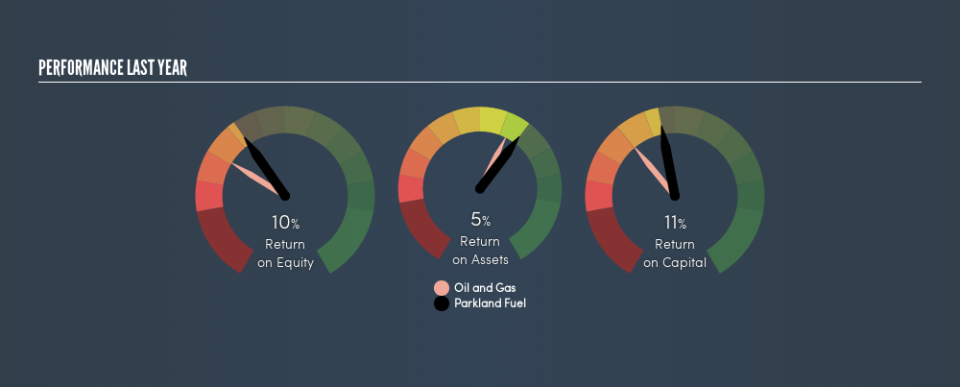What Can We Make Of Parkland Fuel Corporation’s (TSE:PKI) High Return On Capital?

Today we are going to look at Parkland Fuel Corporation (TSE:PKI) to see whether it might be an attractive investment prospect. To be precise, we’ll consider its Return On Capital Employed (ROCE), as that will inform our view of the quality of the business.
First, we’ll go over how we calculate ROCE. Then we’ll compare its ROCE to similar companies. Then we’ll determine how its current liabilities are affecting its ROCE.
Return On Capital Employed (ROCE): What is it?
ROCE measures the amount of pre-tax profits a company can generate from the capital employed in its business. Generally speaking a higher ROCE is better. Overall, it is a valuable metric that has its flaws. Author Edwin Whiting says to be careful when comparing the ROCE of different businesses, since ‘No two businesses are exactly alike.’
How Do You Calculate Return On Capital Employed?
The formula for calculating the return on capital employed is:
Return on Capital Employed = Earnings Before Interest and Tax (EBIT) ÷ (Total Assets – Current Liabilities)
Or for Parkland Fuel:
0.11 = CA$234m ÷ (CA$5.7b – CA$1.5b) (Based on the trailing twelve months to September 2018.)
Therefore, Parkland Fuel has an ROCE of 11%.
View our latest analysis for Parkland Fuel
Is Parkland Fuel’s ROCE Good?
ROCE is commonly used for comparing the performance of similar businesses. Parkland Fuel’s ROCE appears to be substantially greater than the 4.9% average in the Oil and Gas industry. We would consider this a positive, as it suggests it is using capital more effectively than other similar companies. Regardless of where Parkland Fuel sits next to its industry, its ROCE in absolute terms appears satisfactory, and this company could be worth a closer look.
In our analysis, Parkland Fuel’s ROCE appears to be 11%, compared to 3 years ago, when its ROCE was 7.2%. This makes us think the business might be improving.
Remember that this metric is backwards looking – it shows what has happened in the past, and does not accurately predict the future. Companies in cyclical industries can be difficult to understand using ROCE, as returns typically look high during boom times, and low during busts. ROCE is only a point-in-time measure. We note Parkland Fuel could be considered a cyclical business. What happens in the future is pretty important for investors, so we have prepared a free report on analyst forecasts for Parkland Fuel.
What Are Current Liabilities, And How Do They Affect Parkland Fuel’s ROCE?
Liabilities, such as supplier bills and bank overdrafts, are referred to as current liabilities if they need to be paid within 12 months. Due to the way ROCE is calculated, a high level of current liabilities makes a company look as though it has less capital employed, and thus can (sometimes unfairly) boost the ROCE. To counter this, investors can check if a company has high current liabilities relative to total assets.
Parkland Fuel has total liabilities of CA$1.5b and total assets of CA$5.7b. As a result, its current liabilities are equal to approximately 26% of its total assets. A fairly low level of current liabilities is not influencing the ROCE too much.
The Bottom Line On Parkland Fuel’s ROCE
Overall, Parkland Fuel has a decent ROCE and could be worthy of further research. Of course, you might find a fantastic investment by looking at a few good candidates. So take a peek at this free list of companies with modest (or no) debt, trading on a P/E below 20.
For those who like to find winning investments this free list of growing companies with recent insider purchasing, could be just the ticket.
We aim to bring you long-term focused research analysis driven by fundamental data. Note that our analysis may not factor in the latest price-sensitive company announcements or qualitative material.
If you spot an error that warrants correction, please contact the editor at editorial-team@simplywallst.com. This article by Simply Wall St is general in nature. It does not constitute a recommendation to buy or sell any stock, and does not take account of your objectives, or your financial situation. Simply Wall St has no position in the stocks mentioned. Thank you for reading.

 Yahoo Finance
Yahoo Finance 
